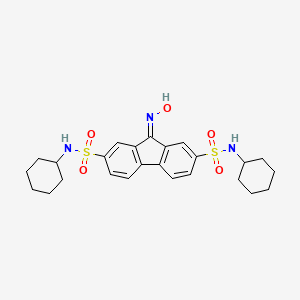Ferroptosis-centered Drug Response Information
General Information of the Drug (ID: ferrodrug0350)
| Name |
FIN56
|
||||
|---|---|---|---|---|---|
| Synonyms |
FIN56; 1083162-61-1; N2,N7-dicyclohexyl-9-(hydroxyimino)-9H-fluorene-2,7-disulfonamide; FIN 56; FIN-56; 2-N,7-N-Dicyclohexyl-9-hydroxyiminofluorene-2,7-disulfonamide; FIN56;FIN 56; SCHEMBL21460308; CHEBI:176419; BCP29145; s8254; AKOS034831611; CCG-269836; CS-7632; BS-14396; HY-103087; C71305; A920909; N,N'-dicyclohexyl-9-(hydroxyimino)-9H-fluorene-2,7-disulfonamide; N(2),N(7)-dicyclohexyl-9-(hydroxyimino)-9H-fluorene-2,7-disulfonamide
Click to Show/Hide
|
||||
| Structure |
 |
||||
| Formula |
C25H31N3O5S2
|
||||
| IUPAC Name |
2-N,7-N-dicyclohexyl-9-hydroxyiminofluorene-2,7-disulfonamide
|
||||
| Canonical SMILES |
C1CCC(CC1)NS(=O)(=O)C2=CC3=C(C=C2)C4=C(C3=NO)C=C(C=C4)S(=O)(=O)NC5CCCCC5
|
||||
| InChI |
InChI=1S/C25H31N3O5S2/c29-26-25-23-15-19(34(30,31)27-17-7-3-1-4-8-17)11-13-21(23)22-14-12-20(16-24(22)25)35(32,33)28-18-9-5-2-6-10-18/h11-18,27-29H,1-10H2
|
||||
| InChIKey |
JLCFMMIWBSZOIS-UHFFFAOYSA-N
|
||||
| PubChem CID | |||||
Full List of Ferroptosis Target Related to This Drug
Phospholipid hydroperoxide glutathione peroxidase (GPX4)
| In total 1 item(s) under this Target | ||||
| Experiment 1 Reporting the Ferroptosis-centered Drug Act on This Target | [1] | |||
| Target for Ferroptosis | Suppressor | |||
| Responsed Disease | Bladder cancer | ICD-11: 2C94 | ||
| Pathway Response | Fatty acid metabolism | hsa01212 | ||
| Autophagy | hsa04140 | |||
| Cell Process | Cell ferroptosis | |||
| Cell autophagy | ||||
| In Vitro Model | J82 cells | Bladder carcinoma | Homo sapiens | CVCL_0359 |
| 253J cells | Bladder carcinoma | Homo sapiens | CVCL_7935 | |
| T24 cells | Bladder carcinoma | Homo sapiens | CVCL_0554 | |
| RT-112 cells | Bladder carcinoma | Homo sapiens | CVCL_1670 | |
| mEFs (Mouse embryonic fibroblasts) | ||||
| Response regulation | Fin56, a type 3 inducer, leads to ferroptosis mainly by promoting GPX4 degradation. Fin56 induces ferroptosis and autophagy in bladder cancer cells and that Fin56-triggered ferroptosis mechanistically depends on the autophagic machinery. | |||
Unspecific Target
| In total 1 item(s) under this Target | |||||
| Experiment 1 Reporting the Ferroptosis-centered Drug Act on This Target | [2] | ||||
| Responsed Disease | Glioblastoma | ICD-11: 2A00 | |||
| Pathway Response | Fatty acid metabolism | hsa01212 | |||
| Cell Process | Cell ferroptosis | ||||
| Cell proliferation | |||||
| In Vitro Model | LN-229 cells | Glioblastoma | Homo sapiens | CVCL_0393 | |
| U118 cells | Astrocytoma | Homo sapiens | CVCL_0633 | ||
| In Vivo Model |
1x105 LN229 cells were injected subcutaneously into the right shoulder of 4-week-old nude mice (SLAC laboratory animal Center; Shanghai, China). 2 weeks later, nude mice (n = 10) were divided into two groups, control group and FIN56 treatment group. Subcutaneous tumors were harvested 30 days after treatment. Tumors were fixed and paraffin-embedded for immunohistochemistry.
Click to Show/Hide
|
||||
| Response regulation | FIN56 decreased cell viability, inhibited cell proliferation and caused cell cycle arrest on gliomaLN229 and U118 cells. Further study showed that FIN56 induced ferroptosis and induced lysosomal membrane permeabilization in a ferroptosis and transfactor EB dependent manner. Animal study demonstrated that FIN56 inhibited glioma growth and caused ferroptosisin vivo. | ||||
References
